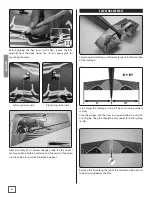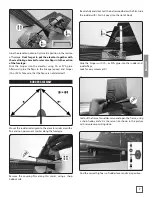
12
BALANCE THE MODEL (C.G.)
More than any other factor, the C.G. (balance point) can
have the greatest effect on how a model flies and may
determine whether or not your first flight will be successful.
If you value this model and wish to enjoy it for many flights,
DO NOT OVERLOOK THIS IMPORTANT PROCEDURE. A
model that is not properly balanced will be unstable and
possibly unflyable.
At this stage the model should be in ready-to-fly condition
with all of the systems in place including the engine, landing
gear, covering and the radio system.
❍
1. Use a felt-tip pen or 1/8"-wide tape to accurately mark
the C.G. on the top of the wing. The C.G. is located 65 mm
back from the leading edge of the wing.
❍
2. With the wing attached to the fuselage, all parts of
the model installed (ready to fly) and with batteries in
position, place the model upside-down on a Great Planes
CG Machine, or lift it upside-down at the balance point
you marked.
❍
3. If the tail drops, the model is “tail heavy” and the battery
pack and/or receiver must be shifted forward or weight
must be added to the nose to balance. If the nose drops,
the model is “nose heavy” and the battery pack and/or
receiver must be shifted aft or weight must be added to
the tail to balance. If possible, relocate the battery pack
and receiver to minimize or eliminate any additional
ballast required. If additional weight is required, nose
weight may be easily added by using a “spinner weight”
(GPMQ4645 for the 1 oz. weight, or GPMQ4646 for the
2 oz. weight). If spinner weight is not practical or is not
enough, use Great Planes (GPMQ4485) “stick-on” lead. A
good place to add stick-on nose weight is to the firewall
(don't attach weight to the cowl–it is not intended
to support weight). Begin by placing incrementally
increasing amounts of weight on the bottom of the fuse
over the firewall until the model balances. Once you
have determined the amount of weight required, it can
be permanently attached. If required, tail weight may be
added by cutting open the bottom of the fuse and gluing
it permanently inside.
Note: Do not rely upon the adhesive on the back of the
lead weight to permanently hold it in place. Over time, the
adhesive may softern and cause the weight to fall off. Use
#2 sheet metal screws, RTV silicone or epoxy to permanently
hold the weight in place.
❍
4. IMPORTANT: If you found it necessary to add any
weight, recheck the C.G. after the weight has been
installed.
BALANCE THE MODEL LATERALLY
❏
❏ ❏
1. With the wing level, have an assistant help you lift
the model by the engine propeller shaft and the bottom of the
fuse under the TE of the fin. Do this several times.
❏
❏ ❏
2. If one wing always drops when you lift the model,
it means that side is heavy. Balance the airplane by adding
weight to the other wing tip. An airplane that has been laterally
balanced will track better in loops and other maneuvers.
SET THE CONTROL THROWS
Use a ruler to accurately measure and set the control throw
of each control surface as indicated in the chart that follows.
If your radio does not have dual rates, we recommend setting
the throws at the low rate settings.NOTE: The throws are
measured at the widest part of the elevators, rudder and
ailerons.
ENGLISH
Summary of Contents for Midi EDGE 540 FLWA4001
Page 15: ...15 PERSONAL NOTES ENGLISH...
Page 16: ...Distributed by www hobbico de...


































